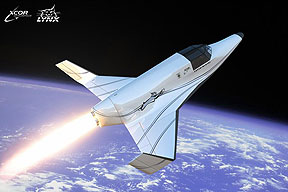[SatNews] This space telescope will be going for a ride...
The Planetary Science Institute (PSI) and XCOR Aerospace have signed a Memorandum of Understanding that lays the groundwork for flying the human-operated Atsa Suborbital Observatory aboard XCOR's Lynx spacecraft. The Atsa project will use crewed reusable suborbital spacecraft equipped with a specially designed telescope to provide low-cost space-based observations above the contaminating atmosphere of Earth, while avoiding some operational constraints of satellite telescope systems.
The Atsa Suborbital Observatory was invented by Vilas and Luke Sollitt, a PSI affiliate scientist who is a professor at The Citadel, The Military College of South Carolina. Vilas, who leads the Atsa project, is a long-time planetary astronomer who recently retired as director of the MMT Observatory (a joint facility of the Smithsonian Institution and the University of Arizona) before joining PSI. Sollitt, the Atsa Deputy Project Scientist, was formerly staff scientist at Northrop Grumman Corp. "NASA has been flying suborbital observatories for decades, on unmanned, disposable rockets. The new manned, reusable commercial platforms will allow us to make repeated observations with a single instrument, but without the need to refurbish it between flights," Sollitt said. "In addition, the short turn-around means we can do many observations or targets."
Atsa means "eagle" in the Navajo language. The facility is optimized for observing solar system objects near the Sun that are difficult to study from orbital observatories such as Hubble and ground-based telescopes. "These are natural targets for instruments on suborbital rockets to observe, but a human-tended facility using the kind of reusable launch vehicle offered by XCOR offers significant cost savings," said Mark Sykes, CEO and Director of PSI, who is also a long-time planetary astronomer and is training to be an Atsa operator.
The Lynx spacecraft will fly to space on a customized flight trajectory and will be capable of precision pointing, allowing the Atsa system with its operator to acquire the desired target and make the planned observations. "We are being approached by many potential customers who are interested in supporting observations of the inner solar system," Vilas said. "We will also be able to support target of opportunity observations for newly discovered objects and other phenomena."
"We're looking forward to flying PSI's Atsa system on Lynx, it will be a groundbreaking experience. The rapid and flexible operations of the Lynx will enable scientists to pick specific targets of interest and the same day fly multiple tailor made observation missions quickly and inexpensively when they want them to be flown," said Khaki Rodway McKee, XCOR's Program Manager.
Public investment still plays a critical role in shaping the future of humans beyond Earth. "NASA is still the tip of the spear," Sykes said. "There are basic questions regarding expanding Earth life to different gravities and the availability and usability of space resources that require NASA to answer. Together, private enterprise and the public sector can realize our dreams of a future in space."



